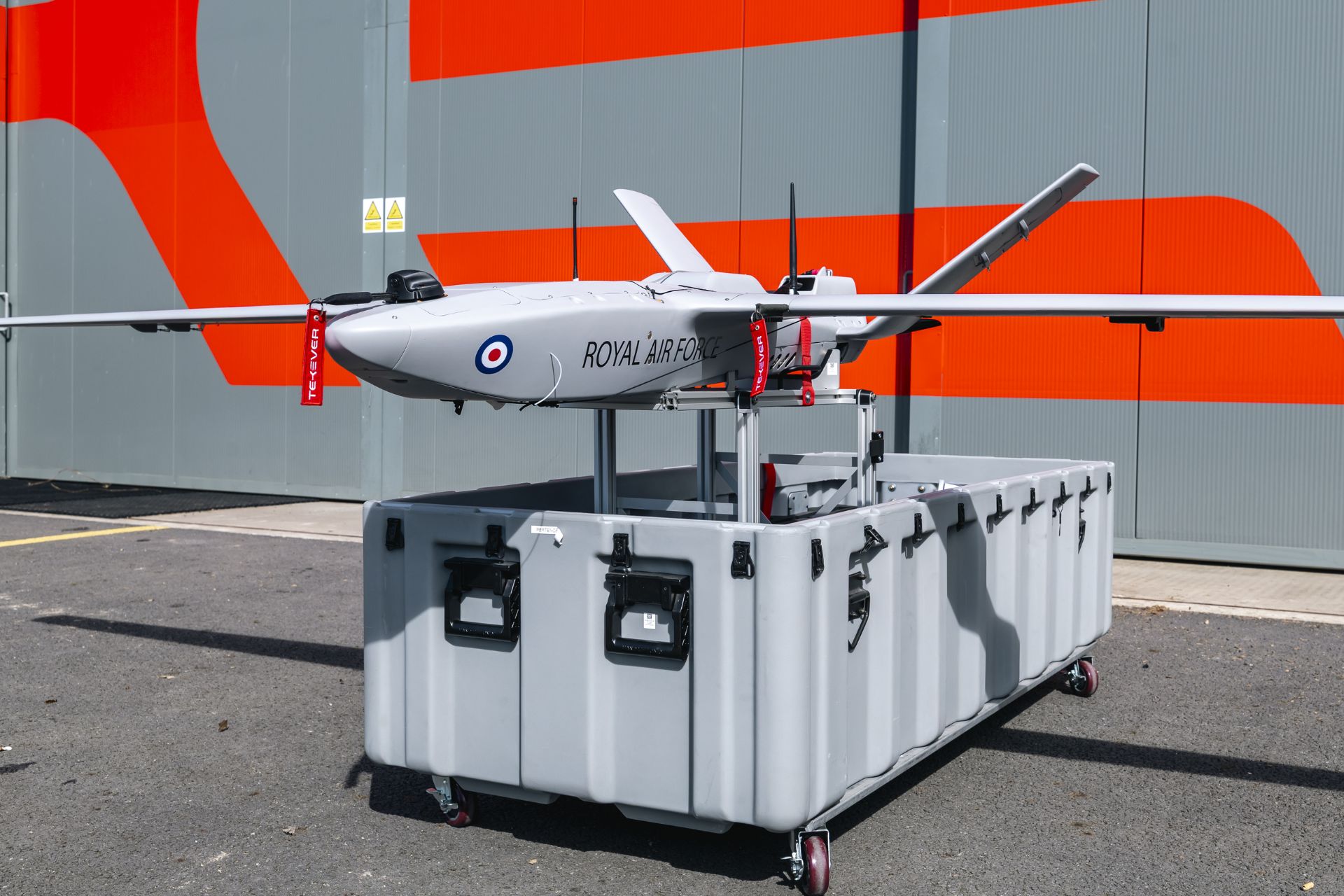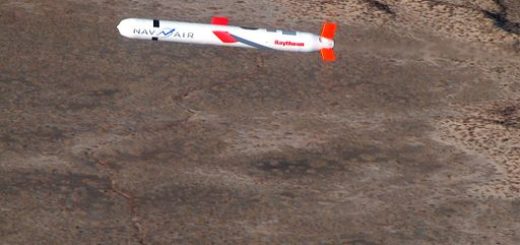UK Royal Air Force Deploys New British-Made StormShroud Drone to Jam Enemy Radars Alongside F-35s

{loadposition bannertop}
{loadposition sidebarpub}
On 2 May 2025, the United Kingdom marked a pivotal moment in the evolution of its military airpower with the official entry into operational service of the StormShroud drone. This new autonomous aerial platform is designed to operate in coordination with the Royal Air Force’s (RAF) crewed combat aircraft, such as the F-35B Lightning and the Typhoon FGR4. As the first in a new generation of Autonomous Collaborative Platforms (ACP), StormShroud embodies a strategic shift in the RAF’s operational doctrine—prioritising manned-unmanned teaming to enhance the survivability and effectiveness of air assets in increasingly contested environments.
Follow Army Recognition on Google News at this link
StormShroud is based on the AR3 platform, developed by British-Portuguese company Tekever, whose systems have already proven effective in real-world operations, notably in Ukraine (Picture source: RAF)
StormShroud is based on the AR3 platform, developed by British-Portuguese company Tekever, whose systems have already proven effective in real-world operations, notably in Ukraine. Ukrainian forces have employed Tekever drones extensively, with over 10,000 flight hours accumulated in intelligence and surveillance roles. Building on this operational experience, the RAF has adapted the AR3 into a dedicated electronic warfare asset by integrating Leonardo UK’s BriteStorm payload. BriteStorm is a lightweight, modular “stand-in jammer” designed to disrupt integrated air defence systems (IADS) by using advanced digital jamming and radar deception techniques. The system includes a Miniature Techniques Generator (MTG) and tailored Transmit Receive Modules (TRMs), enabling it to interfere with enemy radar systems from long distances. BriteStorm also benefits from a reprogrammable, open software architecture, allowing it to be updated quickly in response to new threats and mission requirements.
The integration of StormShroud into RAF service represents not only a technological milestone but also an evolution in capability acquisition. Delivered just one year after the Urgent Capability Requirement (UCR) was approved, StormShroud is among the first RAF systems fielded under a new high-risk, high-agility model. This approach allows for the deployment of critical capabilities on accelerated timelines while balancing the need for risk mitigation and operational assurance. The compressed development cycle was made possible by drawing directly from lessons learned on the Ukrainian battlefield and leveraging existing industrial and technological bases within the UK.
In terms of economic impact, the StormShroud programme supports 200 highly skilled engineering and technical jobs across several regions of the UK, including West Wales, Somerset, and Southampton. The drones are assembled domestically, reinforcing the UK’s defence industrial base and contributing to regional economic development. Furthermore, Tekever has announced a planned £400 million investment over the next five years, aimed at expanding its UK operations and potentially creating up to 1,000 additional jobs. Leonardo UK, which developed the BriteStorm payload in Luton—a hub for British electronic warfare innovation—employs over 1,200 people and remains deeply engaged in broader defence programmes such as the Global Combat Air Programme (GCAP) and the ongoing upgrades to the Eurofighter Typhoon.
StormShroud will be operated by 216 Squadron, the RAF’s specialist unit for integrating and testing uncrewed and autonomous systems. The squadron’s personnel will include both regular RAF members and reservists from the Royal Auxiliary Air Force (RAuxAF), trained to operate the system in small, agile teams capable of deploying in high-threat environments. This hybrid force structure reflects the RAF’s broader vision of flexible, distributed operations enabled by human-machine teaming.
This new autonomous aerial platform is designed to operate in coordination with the Royal Air Force’s (RAF) crewed combat aircraft, such as the F-35B Lightning and the Typhoon FGR4 (Picture source: RAF)
The platform is intended to fly ahead of high-value crewed aircraft, jamming and deceiving enemy radar systems to create gaps in hostile air defences. This role significantly enhances the survivability of RAF aircraft while freeing pilots and other critical personnel from having to operate in the most dangerous parts of contested airspace. Notably, StormShroud introduces high-end electronic warfare capabilities without requiring human operators onboard, opening new possibilities for distributed, multi-domain operations.
The system’s introduction coincides with a wider reconfiguration of the UK’s defence posture. As outlined in recent government policy, the UK has committed to increasing its defence spending to 2.5% of GDP by 2027. This investment is framed not only as a response to growing global instability but also as a driver of economic development and technological innovation. During a visit to the Leonardo UK facility in Luton, Prime Minister Keir Starmer highlighted the strategic and industrial significance of the StormShroud programme. He emphasised that investment in defence is both a security imperative and an opportunity to build sustainable, well-paid employment across the country.
The Prime Minister also linked StormShroud’s deployment to the UK’s broader role on the international stage. The announcement comes shortly after the departure of the UK’s Carrier Strike Group—led by HMS Prince of Wales—on an eight-month deployment across the Indo-Pacific. This mission, which includes joint operations and port visits in over 30 countries, underscores the UK’s commitment to safeguarding critical maritime trade routes and strengthening alliances in the region. Meanwhile, the UK continues to play an active role in supporting Ukraine, not only through equipment transfers and diplomatic initiatives, but also by promoting industrial cooperation and joint development of defence capabilities within the “Coalition of the Willing.”
The StormShroud programme exemplifies a multifaceted shift in British defence policy—blending rapid technological integration, industrial growth, and strategic adaptability. It reflects the RAF’s ambition to build a future force that can respond to complex, evolving threats through a combination of manned and unmanned assets. As a new electronic warfare platform, StormShroud offers operational utility, industrial benefits, and doctrinal innovation. It reinforces the UK’s capacity to project power and defend its interests through an increasingly autonomous and networked force structure, anchored in domestic expertise and international collaboration.

{loadposition bannertop}
{loadposition sidebarpub}
On 2 May 2025, the United Kingdom marked a pivotal moment in the evolution of its military airpower with the official entry into operational service of the StormShroud drone. This new autonomous aerial platform is designed to operate in coordination with the Royal Air Force’s (RAF) crewed combat aircraft, such as the F-35B Lightning and the Typhoon FGR4. As the first in a new generation of Autonomous Collaborative Platforms (ACP), StormShroud embodies a strategic shift in the RAF’s operational doctrine—prioritising manned-unmanned teaming to enhance the survivability and effectiveness of air assets in increasingly contested environments.
StormShroud is based on the AR3 platform, developed by British-Portuguese company Tekever, whose systems have already proven effective in real-world operations, notably in Ukraine (Picture source: RAF)
StormShroud is based on the AR3 platform, developed by British-Portuguese company Tekever, whose systems have already proven effective in real-world operations, notably in Ukraine. Ukrainian forces have employed Tekever drones extensively, with over 10,000 flight hours accumulated in intelligence and surveillance roles. Building on this operational experience, the RAF has adapted the AR3 into a dedicated electronic warfare asset by integrating Leonardo UK’s BriteStorm payload. BriteStorm is a lightweight, modular “stand-in jammer” designed to disrupt integrated air defence systems (IADS) by using advanced digital jamming and radar deception techniques. The system includes a Miniature Techniques Generator (MTG) and tailored Transmit Receive Modules (TRMs), enabling it to interfere with enemy radar systems from long distances. BriteStorm also benefits from a reprogrammable, open software architecture, allowing it to be updated quickly in response to new threats and mission requirements.
The integration of StormShroud into RAF service represents not only a technological milestone but also an evolution in capability acquisition. Delivered just one year after the Urgent Capability Requirement (UCR) was approved, StormShroud is among the first RAF systems fielded under a new high-risk, high-agility model. This approach allows for the deployment of critical capabilities on accelerated timelines while balancing the need for risk mitigation and operational assurance. The compressed development cycle was made possible by drawing directly from lessons learned on the Ukrainian battlefield and leveraging existing industrial and technological bases within the UK.
In terms of economic impact, the StormShroud programme supports 200 highly skilled engineering and technical jobs across several regions of the UK, including West Wales, Somerset, and Southampton. The drones are assembled domestically, reinforcing the UK’s defence industrial base and contributing to regional economic development. Furthermore, Tekever has announced a planned £400 million investment over the next five years, aimed at expanding its UK operations and potentially creating up to 1,000 additional jobs. Leonardo UK, which developed the BriteStorm payload in Luton—a hub for British electronic warfare innovation—employs over 1,200 people and remains deeply engaged in broader defence programmes such as the Global Combat Air Programme (GCAP) and the ongoing upgrades to the Eurofighter Typhoon.
StormShroud will be operated by 216 Squadron, the RAF’s specialist unit for integrating and testing uncrewed and autonomous systems. The squadron’s personnel will include both regular RAF members and reservists from the Royal Auxiliary Air Force (RAuxAF), trained to operate the system in small, agile teams capable of deploying in high-threat environments. This hybrid force structure reflects the RAF’s broader vision of flexible, distributed operations enabled by human-machine teaming.

This new autonomous aerial platform is designed to operate in coordination with the Royal Air Force’s (RAF) crewed combat aircraft, such as the F-35B Lightning and the Typhoon FGR4 (Picture source: RAF)
The platform is intended to fly ahead of high-value crewed aircraft, jamming and deceiving enemy radar systems to create gaps in hostile air defences. This role significantly enhances the survivability of RAF aircraft while freeing pilots and other critical personnel from having to operate in the most dangerous parts of contested airspace. Notably, StormShroud introduces high-end electronic warfare capabilities without requiring human operators onboard, opening new possibilities for distributed, multi-domain operations.
The system’s introduction coincides with a wider reconfiguration of the UK’s defence posture. As outlined in recent government policy, the UK has committed to increasing its defence spending to 2.5% of GDP by 2027. This investment is framed not only as a response to growing global instability but also as a driver of economic development and technological innovation. During a visit to the Leonardo UK facility in Luton, Prime Minister Keir Starmer highlighted the strategic and industrial significance of the StormShroud programme. He emphasised that investment in defence is both a security imperative and an opportunity to build sustainable, well-paid employment across the country.
The Prime Minister also linked StormShroud’s deployment to the UK’s broader role on the international stage. The announcement comes shortly after the departure of the UK’s Carrier Strike Group—led by HMS Prince of Wales—on an eight-month deployment across the Indo-Pacific. This mission, which includes joint operations and port visits in over 30 countries, underscores the UK’s commitment to safeguarding critical maritime trade routes and strengthening alliances in the region. Meanwhile, the UK continues to play an active role in supporting Ukraine, not only through equipment transfers and diplomatic initiatives, but also by promoting industrial cooperation and joint development of defence capabilities within the “Coalition of the Willing.”
The StormShroud programme exemplifies a multifaceted shift in British defence policy—blending rapid technological integration, industrial growth, and strategic adaptability. It reflects the RAF’s ambition to build a future force that can respond to complex, evolving threats through a combination of manned and unmanned assets. As a new electronic warfare platform, StormShroud offers operational utility, industrial benefits, and doctrinal innovation. It reinforces the UK’s capacity to project power and defend its interests through an increasingly autonomous and networked force structure, anchored in domestic expertise and international collaboration.






